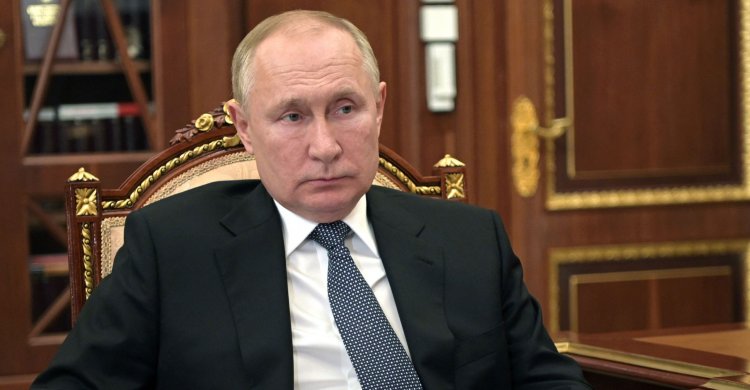False Flag Isn’t Russia’s Only Chemical Weapons Scenario
It’s very possible that Russia might use chemical weapons in a false flag operation in Ukraine, based on information the Biden administration has shared with... Read More The post False Flag Isn’t Russia’s Only Chemical Weapons Scenario appeared first on The Daily Signal.

It’s very possible that Russia might use chemical weapons in a false flag operation in Ukraine, based on information the Biden administration has shared with the public on that frightening scenario.
But a false flag operation isn’t the only option for Russia to use chemical weapons in Ukraine, potentially blaming a strike on any number of possible Ukrainian, Russian, or even, Belarusian civilian or military targets on Ukrainian, U.S., or even NATO forces.
Instead, considering the seesawing state of the battle for the future of Ukraine, Moscow could decide to use chemical weapons against Ukrainian forces or civilians to gain a potentially decisive advantage in the war.
But why use chemical weapons? There are a couple of reasons.
The first is to terrorize the Ukrainian government and its people by using a weapon of mass destruction. For instance, the Russians could strike an undefended Ukrainian village with a chemical weapon, such as industrial chlorine or the nerve agent Novichok.
Many, undoubtedly, would die a horrible, agonizing death from those weapons. The news of the atrocity would spread quickly in the information space, causing mass panic and huge refugee flows across Ukraine.
The horrific attack would serve as a serious warning to those resisting Russian aggression both inside and outside the Ukrainian government: If you continue to oppose the invasion, you, too, may suffer the same fate as those innocent villagers.
A second reason would be to potentially destroy entrenched Ukrainian military and paramilitary forces engaged in urban warfare. Street-to-street and door-to-door fighting in large towns and, especially, cities, can be very dangerous and bloody for an attacking force.
Indeed, the defender can have a big advantage, knowing the topography, streets, alleys, and buildings, which allows for effective military planning and the preparation of fortifications and fields of fire to blunt an offensive.
In some cases, to win in an urban environment, it is often said that it might take 10 attackers for every one defender.
If Russia intends to capture the Ukrainian capital, Kyiv, a huge city of a few hundred square miles, it could be very difficult for its forces—and turn out to be exceedingly costly in terms of the potential loss of personnel and equipment.
Instead of storming any city, Russia could saturate all or parts of a city and its well dug-in defenders with a variety of chemical weapons, using a range of delivery platforms from aircraft to missiles to artillery.
Unprotected from the unleashed Russian chemical agents and unable to stop the spread of the poisonous gas across the city, the Ukrainian defenders would be in great peril despite their well-built bastions.
Any of these tactics could arguably make a big difference in the battle for Ukraine.
Unfortunately, those terrible tactics using deadly chemical weapons aren’t unprecedented in recent military history.
Just look at what Russia’s ally Syria did with chemical weapons during some of the darkest days of the Syrian civil war.
Damascus, on a number of occasions, used chlorine gas and sarin nerve agent against its opponents, including innocent civilians. As a military ally of Damascus, Moscow certainly would have learned much from its Syrian sidekicks.
The State Department claims Russia has an active, undeclared chemical weapons program and can’t verify that Moscow has destroyed its chemical weapons stockpiles as required under the Chemical Weapons Convention.
Indeed, the Kremlin has used those weapons (e.g., Novichok) against political opponents and others in recent years. As such, it should be expected that Russia would be willing to use chemical weapons in Ukraine.
Moreover, Russia has troops specializing in nuclear, chemical, and biological defense. These specialized forces are tasked with assisting the Russian military in operating in a contaminated battle space if necessary.
In response, NATO is expected to agree to provide assistance to Ukraine against this threat of Russian weapons of mass destruction at this week’s emergency summit in Brussels.
Of course, Russia wouldn’t admit responsibility for using chemical weapons in Ukraine, which would violate international law, well-established global norms, and the Chemical Weapons Convention, of which Russia is a signatory.
Undoubtedly, Moscow would call upon its accusers to prove Russian involvement in such a heinous act of violence.
While there might be strong U.S., NATO, Ukrainian, or other information and even “smoking gun” intelligence that indicates Russian responsibility, Moscow would deny it, asking for independent evidence.
Obtaining that proof would be hard to get in a hot war zone.
The point here is that there are plenty of reasons to be concerned about Russia’s potential use of chemical weapons in Ukraine—and it’s not only the possibility of a false flag operation to justify their unprovoked and unjust invasion of its neighbor.
As such, the U.S., our allies, and partners need to be thinking about these other sobering scenarios for when Russia might unleash its chemical weapons on Ukraine.
Have an opinion about this article? To sound off, please email letters@DailySignal.com and we’ll consider publishing your edited remarks in our regular “We Hear You” feature. Remember to include the url or headline of the article plus your name and town and/or state.
The post False Flag Isn’t Russia’s Only Chemical Weapons Scenario appeared first on The Daily Signal.
















:quality(85):upscale()/2025/01/08/844/n/1922398/cde2aeac677eceef03f2d1.00424146_.jpg)


